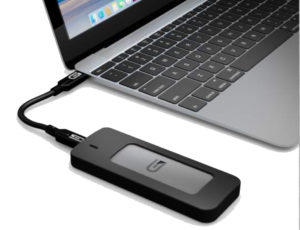 Exercise Your SSDs! Like Any Other Storage Drive
Exercise Your SSDs! Like Any Other Storage Drive
When designing a drive, engineers assume that some energy will always be applied. Leaving any drive on a shelf without power for years, will almost certainly lead eventually to lost data. For those of us with vast archives stored on umpteen drives sitting idle in a closet or warehouse, the failure of a single large drive or RAID array can be devastating.
Mechanical drives are inherently slow, relatively speaking, so moving large files can significantly reduce one’s productivity. Beyond that, the high failure rate of mechanical drives is an ongoing threat. The distance between the platters is measured literally in wavelengths of light, so there isn’t much room for dislocation of the spinning disks due to shock. This peril from inadvertent impact is in addition to the normal wear and tear of mechanical arms moving continuously back and forth inside the drive.
For documentary shooters operating in a rough-and-tumble environment, the move to flash storage is a godsend. SSDs contain no moving parts, so there is little worry from dropping a memory card or SSD while chasing a herd of wildebeests, or operating a camera in a high vibration environment like a racecar and fighter jet.
SSDs also offer 100x the speed of mechanical drives, so it’s not surprising that HDDs these days are rapidly losing relevance. The lower cost per gig still makes mechanical drives a good choice for some reality TV and backup applications, but as camera files grow larger with higher resolution 4K production, the SSD’s greater speed becomes imperative order to maintain a reasonably productive workflow.
Right now the capacity of mechanical drives is reaching the upper limit. Due to heat and physical constraints, there are only so many platters that can be placed one atop of the other inside an HDD. SSD flash memory, on the other hand, may be stacked in dozens of layers; with each new generation of module offering a greater number of bits. Samsung is moving from 256Gb flash chips in 48-layers to 512Gb chips in 64-layers.
So how much should you exercise your HDD and SSD drives? Samsung states its consumer drives can be left unpowered safely for about a year. In contrast, enterprise data drives found in rack servers are designed for heavy use with continuous data loads, and offer only a six-month window of reliability without power. Such guidelines are vital to keep in mind as some shooters may not use a particular drive or memory card for many months or even years, and for them, it is important to power up their SSDs from time to time, to ensure a satisfactory performance and reliability.
One other thing. SSDs have a limited life expectancy. The silicon material in flash memory only supports so many read-write cycles, and will, over time, eventually lose efficiency As a practical matter, the EOL of solid-state drives should not pose much of a problem however. Depending on the load and level of use, most consumer SSDs writing 10-20GB per day have an estimated EOL of 120 years. Most of us I would think will have replaced our cameras, recording media, and storage drives, long before then.

All drives, including SSDs, require regular exercise. Ordinary consumer drives should be powered up at least once a year to maintain reliable access to stored data. Professional series and enterprise-level drives require powering up twice as often, about every six months, to ensure maximum efficiency and long life.